
(a)
Interpretation:
For the given proposed transforms, it is to be determined whether it leads to a synthetic trap (i.e. will not proceed as planned in the forward direction) or not along with the reasoning.
Concept introduction:
A particular reaction is undone by performing a transform that depends on the specific location in the target molecule where we want the changes to occur. In doing so, we may encounter synthetic traps. A synthetic trap is the proposed mechanism that prevents the reaction to occur in the forward direction as planned. From the reactions used for
Answer to Problem 13.6P
The synthesis will proceed as planned. The forward reaction is shown below:
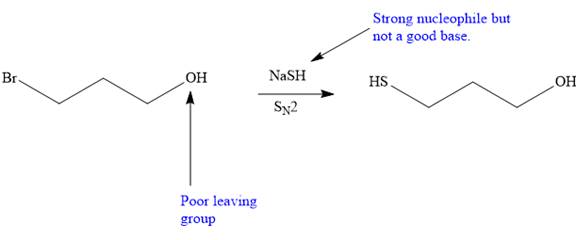
Explanation of Solution
The given proposed transform is:

The target molecule is on the left side. In the target molecule, there are two functional groups present, a cyanide and hydroxyl group. In order to carry out this transform, sodium cyanide (

Thus, the proposed transform does not lead to a synthetic trap and will proceed as planned.
The possibility of the forward reaction in the proposed mechanism is determined on the basis of the functional group transformation reactions, charge stability, and strength of the reagents used.
(b)
Interpretation:
For the given proposed transforms, it is to be determined whether it leads to a synthetic trap (i.e. will not proceed as planned in the forward direction) or not along with the reasoning.
Concept introduction:
A particular reaction is undone by performing a transform that depends on the specific location in the target molecule where we want the changes to occur. In doing so, we may encounter synthetic traps. A synthetic trap is the proposed mechanism that prevents the reaction to occur in the forward direction as planned. From the reactions used for functional group transformation and considering the factors like charge stability and strength of the reagent used, one can determine whether the proposed transform leads to a synthetic trap or not.
Answer to Problem 13.6P
The synthesis will proceed as planned. The forward reaction is shown below:
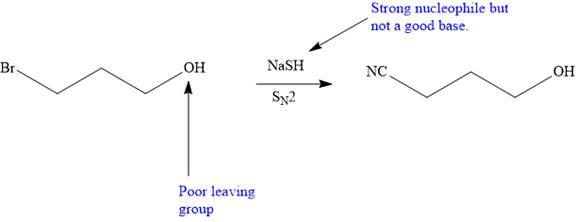
Explanation of Solution
The given proposed transform is:
![]()
The target molecule is on the left side. In the target molecule, there are two functional groups present,
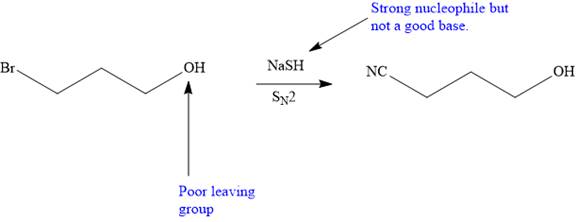
Thus, the proposed transform does not lead to a synthetic trap and will proceed as planned.
The possibility of the forward reaction in the proposed mechanism is determined on the basis of the functional group transformation reactions, charge stability, and strength of the reagents used.
(c)
Interpretation:
For the given proposed transforms, it is to be determined whether it leads to a synthetic trap (i.e. will not proceed as planned in the forward direction) or not along with the reasoning.
Concept introduction:
A particular reaction is undone by performing a transform that depends on the specific location in the target molecule where we want the changes to occur. In doing so, we may encounter synthetic traps. A synthetic trap is the proposed mechanism that prevents the reaction to occur in the forward direction as planned. From the reactions used for functional group transformation, and considering the factors like charge stability and strength of the reagent used, one can determine whether the proposed transform leads to a synthetic trap or not.
Answer to Problem 13.6P
The synthesis will proceed as planned. The forward reaction is shown below:
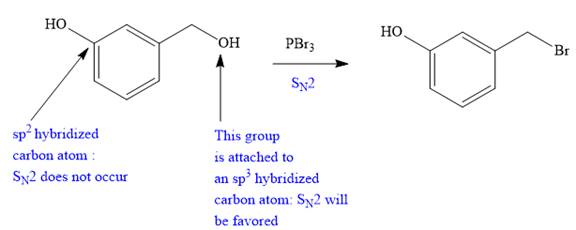
Explanation of Solution
The given proposed transform is:

The target molecule is on the left side. In the target molecule, there are two functional groups present, alkyl halide and hydroxyl group.

Thus, the proposed transform does not lead to a synthetic trap and will proceed as planned.
The possibility of the forward reaction in the proposed mechanism is determined on the basis of the functional group transformation reactions, charge stability, and strength of the reagents used.
(d)
Interpretation:
For the given proposed transforms, it is to be determined whether it leads to a synthetic trap (i.e. will not proceed as planned in the forward direction) or not along with the reasoning.
Concept introduction:
A particular reaction is undone by performing a transform that depends on the specific location in the target molecule where we want the changes to occur. In doing so, we may encounter synthetic traps. A synthetic trap is the proposed mechanism that prevents the reaction to occur in the forward direction as planned. From the reactions used for functional group transformation, and considering the factors like charge stability and strength of the reagent used, one can determine whether the proposed transform leads to the synthetic trap or not.
Answer to Problem 13.6P
The synthesis will not proceed as planned.
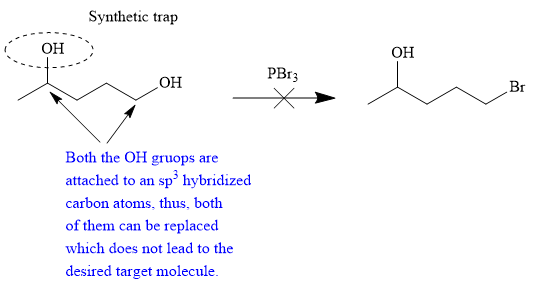
The proposed synthesis is a synthetic trap, and the reaction will not proceed as planned in the forward direction.
Explanation of Solution
The given proposed transform is:

The target molecule is on the left side while the proposed reactant molecule is on the right side. In the target molecule, there are two functional groups present, alcohol and alkyl halide. Alkyl halides are prepared from corresponding alcohols when they are treated with phosphorous bromide/chloride in an

The possibility of the forward reaction in the proposed mechanism is determined on the basis of the functional group transformation reactions, charge stability, and strength of the reagents used.
(e)
Interpretation:
For the given proposed transforms, it is to be determined whether it leads to a synthetic trap (i.e. will not proceed as planned in the forward direction) or not along with the reasoning.
Concept introduction:
A particular reaction is undone by performing a transform that depends on the specific location in the target molecule where we want the changes to occur. In doing so, we may encounter synthetic traps. A synthetic trap is the proposed mechanism that prevents the reaction to occur in the forward direction as planned. From the reactions used for functional group transformation, and considering the factors like charge stability and strength of the reagent used, one can determine whether the proposed transform leads to the synthetic trap or not.
Answer to Problem 13.6P
The synthesis will not proceed as planned.

The proposed synthesis is a synthetic trap, and the reaction will not proceed as planned in the forward direction.
Explanation of Solution
The given proposed transform is:
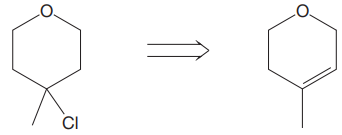
The target molecule is on the left side while the proposed reactant molecule is on the right side. In the target molecule, there are two functional groups present, ether and alkyl halide. Alkyl halides are prepared from
As the reaction does not yield the desired product, we would say that the proposed synthesis is a synthetic trap, and the reaction will not proceed as planned in the forward direction.

The possibility of the forward reaction in the proposed mechanism is determined on the basis of the functional group transformation reactions, charge stability, and strength of the reagents used.
(f)
Interpretation:
For the given proposed transforms it is to be determined whether it leads to a synthetic trap (i.e. will not proceed as planned in the forward direction) or not along with the reasoning.
Concept introduction:
A particular reaction is undone by performing a transform that depends on the specific location in the target molecule where we want the changes to occur. In doing so, we may encounter synthetic traps. A synthetic trap is the proposed mechanism that prevents the reaction to occur in the forward direction as planned. From the reactions used for functional group transformation, and considering the factors like charge stability and strength of the reagent used, one can determine whether the proposed transform leads to the synthetic trap or not.
Answer to Problem 13.6P
The synthesis will not proceed as planned.

The proposed synthesis is a synthetic trap, and the reaction will not proceed as planned in the forward direction.
Explanation of Solution
The given proposed transform is:

The target molecule is on the left side while the proposed reactant molecule is on the right side. In the target molecule, there are two functional groups present,
As the reaction does not yield the desired product, we would say that, the proposed synthesis is a synthetic trap and the reaction will not proceed as planned in the forward direction.

The possibility of the forward reaction in the proposed mechanism is determined on the basis of the functional group transformation reactions, charge stability, and strength of the reagents used.
Want to see more full solutions like this?
Chapter 13 Solutions
EBK ORGANIC CHEMISTRY: PRINCIPLES AND M
- For each reaction below, decide if the first stable organic product that forms in solution will create a new CC bond, and check the appropriate box. Next, for each reaction to which you answered "Yes" to in the table, draw this product in the drawing area below. Note for advanced students: for this problem, don't worry if you think this product will continue to react under the current conditions - just focus on the first stable product you expect to form in solution. དྲ。 ✗MgBr ? O CI Will the first product that forms in this reaction create a new C-C bond? Yes No • ? Will the first product that forms in this reaction create a new CC bond? Yes No × : ☐ Xarrow_forwardPredict the major products of this organic reaction: OH NaBH4 H ? CH3OH Note: be sure you use dash and wedge bonds when necessary, for example to distinguish between major products with different stereochemistry. Click and drag to start drawing a structure. ☐ : Sarrow_forwardPredict the major products of this organic reaction: 1. LIAIHA 2. H₂O ? Note: be sure you use dash and wedge bonds when necessary, for example to distinguish between major products with different stereochemistry. Click and drag to start drawing a structure. X : ☐arrow_forward
- For each reaction below, decide if the first stable organic product that forms in solution will create a new C - C bond, and check the appropriate box. Next, for each reaction to which you answered "Yes" to in the table, draw this product in the drawing area below. Note for advanced students: for this problem, don't worry if you think this product will continue to react under the current conditions - just focus on the first stable product you expect to form in solution. NH2 tu ? ? OH Will the first product that forms in this reaction create a new CC bond? Yes No Will the first product that forms in this reaction create a new CC bond? Yes No C $ ©arrow_forwardAs the lead product manager at OrganometALEKS Industries, you are trying to decide if the following reaction will make a molecule with a new C-C bond as its major product: 1. MgCl ? 2. H₂O* If this reaction will work, draw the major organic product or products you would expect in the drawing area below. If there's more than one major product, you can draw them in any arrangement you like. Be sure you use wedge and dash bonds if necessary, for example to distinguish between major products with different stereochemistry. If the major products of this reaction won't have a new CC bond, just check the box under the drawing area and leave it blank. Click and drag to start drawing a structure. This reaction will not make a product with a new CC bond. G marrow_forwardIncluding activity coefficients, find [Hg22+] in saturated Hg2Br2 in 0.00100 M NH4 Ksp Hg2Br2 = 5.6×10-23.arrow_forward
- give example for the following(by equation) a. Converting a water insoluble compound to a soluble one. b. Diazotization reaction form diazonium salt c. coupling reaction of a diazonium salt d. indacator properties of MO e. Diazotization ( diazonium salt of bromobenzene)arrow_forward2-Propanone and ethyllithium are mixed and subsequently acid hydrolyzed. Draw and name the structures of the products.arrow_forward(Methanesulfinyl)methane is reacted with NaH, and then with acetophenone. Draw and name the structures of the products.arrow_forward
- 3-Oxo-butanenitrile and (E)-2-butenal are mixed with sodium ethoxide in ethanol. Draw and name the structures of the products.arrow_forwardWhat is the reason of the following(use equations if possible) a.) In MO preperation through diazotization: Addition of sodium nitrite in acidfied solution in order to form diazonium salt b.) in MO experiment: addition of sodium hydroxide solution in the last step to isolate the product MO. What is the color of MO at low pH c.) In MO experiment: addition of sodium hydroxide solution in the last step to isolate the product MO. What is the color of MO at pH 4.5 d.) Avoiding not cooling down the reaction mixture when preparing the diazonium salt e.) Cbvcarrow_forwardA 0.552-g sample of an unknown acid was dissolved in water to a total volume of 20.0 mL. This sample was titrated with 0.1103 M KOH. The equivalence point occurred at 29.42 mL base added. The pH of the solution at 10.0 mL base added was 3.72. Determine the molar mass of the acid. Determine the Ka of the acid.arrow_forward
 Organic Chemistry: A Guided InquiryChemistryISBN:9780618974122Author:Andrei StraumanisPublisher:Cengage Learning
Organic Chemistry: A Guided InquiryChemistryISBN:9780618974122Author:Andrei StraumanisPublisher:Cengage Learning
